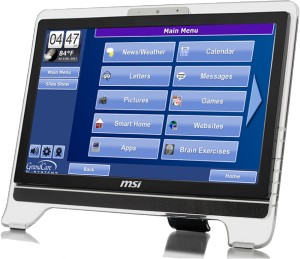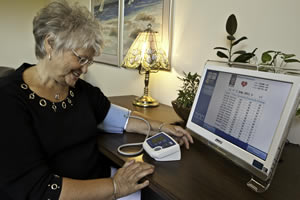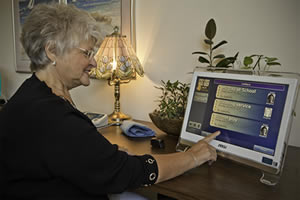Just thought we’d share a press story that was written about one of our dealers in Minnesota, Cybermation!
The tele-health industry is garnering a great deal of attention these days. There is more than one reason this is occurring. The baseline is that the senior and disabled population is rapidly growing, and hence, the expense to care for this demographic is also rapidly growing. To further magnify this, the nation’s economic situation creates additional, overwhelming difficulties to provide the necessary services with limited financial resources.
 One solution is the GrandCare system, configured and developed by Cybermation in Waite Park, MN. Not only does GrandCare benefit our aging and disabled population, but it provides a system to remain independent in the home of their choice.
One solution is the GrandCare system, configured and developed by Cybermation in Waite Park, MN. Not only does GrandCare benefit our aging and disabled population, but it provides a system to remain independent in the home of their choice.
Products targeting remote health services have been in use for years. Health care organizations and hospitals have implemented consumer electronic devices that are FDA compliant and provide a specific function, e.g., blood pressure, weight, glucose levels, etc. Tremendous cost savings and better care have been two primary results. More recently, products that help track activities of daily living (ADL) have also improved people’s lives and health by providing data that addresses the living patterns and tasks that must successfully be performed for someone to continue to live independently in their home.
Various electronic devices, from simple machines for emailing, personal computers, and more recently iPads and similar devices have all provided the opportunity for someone to have remote communication with family members, friends and caregivers in various ways, such as email, pictures, faxes, text messages, even video conferencing from free services such as Skype.
Products have and will continue to evolve that embrace the social, clinical and ADL aspects of maintaining, even improving the health of a person that wishes to remain in their home. No product has more completely and holistically embraced all aspects of these facets of tele-health than the HomeBase system from GrandCare system.
Available since 2006, GrandCare Systems is a pioneer in the aging, disabled and technology digital home health industry. The system integrates various remote monitoring technologies to provide an array of wellness and activity information, easily accessible by health care professionals and family members via the Internet.
GrandCare allows remote caregivers and health care professionals access to detailed information on the resident’s general activity levels, activities of daily living, home environment, health data, medication adherence, and more. GrandCare notices sudden changes in behavior, drastic activity level changes, noncompliance, and other critical issues, which can be programmed to notify the correct caregiver via text, email or phone call. GrandCare can also send care coordination notes, caregiving reports to designated caregivers and can even prompt a resident with a helpful reminder or cognitive assist.
GrandCare’s Smart home features can provide residents a variety of simple enhancements to daily living, including safe path lighting for late night bathroom trips, temperature moderation and secure call screening.
To the resident, the GrandCare system is a friendly, interactive connection to family, one touch video chat, a digital picture frame, access to services, games and videos. It is intuitive and easy to use with large, simple touch-screen buttons. The GrandCare system can also use switche method of operation. GrandCare is a helpful, resourceful, social connection and pure enjoyment!
All of these features and more are available for less cost than one month in assisted living – certainly a relevant consideration in today’s economic times. Quantitative benefits of this magnitude are certainly going to catch the eye of any party facing the extraordinary costs associated with caring for the elderly.
However, it’s Cybermation’s sincere belief that these quantitative benefits are trumped by the wealth of qualitative benefits. Indeed, social workers and clinical workers alike have a common belief that the simple devices that deliver either a clinical, social, or environmental benefit deliver net-positive value both quantitatively and qualitatively. GrandCare by Cybermation, however, provides a far more holistic, encompassing approach that successfully creates a relationship by a tailored blend of services to both the individual as well as the caregivers.
Caregiving in this day and age is both a big business as well as a very demanding responsibility in the diverse, dynamic, fast-paced environment where the family unit can be widely dispersed. History shows that technology has been the predominant catalyst for change and benefit, and considering the plethora of advanced technologies available to be developed and applied, there’s little wonder that GrandCare is at the forefront.
The final link in the process is to bring the proven product to the individual and their loved one. GrandCare made a deliberate decision years ago that in order to effectively determine the individual needs, install the system properly, and to provide adequate support on an on-going basis, required a committed, consistent relationship with the entire family. Hence, a decentralized sales and distribution process was implemented with a high degree of success. Selected system integrators throughout the country have a very active relationship with GrandCare’s West Bend, WI office. GrandCare also developed a remote support system for their dealers that allows easy hardware and software support. The net result is an informed, active sales and support channel that provides the GrandCare user and caregivers with the personalized experience a system of this nature requires.
For more information on Cybermation and the GrandCare system, visit their website at www.cybermationinc.com or call (320) 255.7027, email sales@cybermationinc.com
EquipAlife has installed demonstration units of GrandCare in each of their seven offices located through the state. These devices can be either be used at the office or can be taken home for a 30-day “test drive” to experience how GrandCare can be a tremendous asset in the health and wellness of the individual as well as assist people in the caregiver process.
Contact EquipALife at 763.479.8239, toll free at 1.866.535.8239 or email info@atmn.org and set up a time to have a “GrandCare Experience”.
 “PREDICTION – mHEALTH REVIVES MONITORING: The stationary nature of in-home activity and telehealth monitoring will give way to a disconnect-and-go tablet world that can be docked at home and plays nicely with a cell/smart cellular model. For those walking the floors at CES, you will see tablet apps of every type flowering hither and yon – perhaps you’ll see them tether to a phone. RIM, the anti-marketer, produced an early version of this with the Playbook-BlackBerry tethering. Why not a few tablet apps for seniors (in addition to health and activity monitoring) that sync up with a phone-like device? It may be like trying to cram a large box into a flat rectangle, to start at the hardware end — look at Care Innovations Guide, for example. Why not a partnership between a fitness device vendor (like Fitbit or Philips DirectLife) and a remote monitoring vendor like BeClose or Healthsense? And software-only products like Independa and GrandCare may well benefit from both platform flexibility and a new interest in combining activity sensors and health monitoring.”
“PREDICTION – mHEALTH REVIVES MONITORING: The stationary nature of in-home activity and telehealth monitoring will give way to a disconnect-and-go tablet world that can be docked at home and plays nicely with a cell/smart cellular model. For those walking the floors at CES, you will see tablet apps of every type flowering hither and yon – perhaps you’ll see them tether to a phone. RIM, the anti-marketer, produced an early version of this with the Playbook-BlackBerry tethering. Why not a few tablet apps for seniors (in addition to health and activity monitoring) that sync up with a phone-like device? It may be like trying to cram a large box into a flat rectangle, to start at the hardware end — look at Care Innovations Guide, for example. Why not a partnership between a fitness device vendor (like Fitbit or Philips DirectLife) and a remote monitoring vendor like BeClose or Healthsense? And software-only products like Independa and GrandCare may well benefit from both platform flexibility and a new interest in combining activity sensors and health monitoring.”



 The GrandCare system was the first system to combine socialization, activities of daily living (ADLs) and telehealth monitoring, which together provide peace of mind for family members living close by or long distance. With “wireless” Bluetooth, X10 and ZWave sensors throughout the home, family and caregivers can monitor the senior’s health and home. No computer skills are needed to operate the easy to use senior home care solution that features an interactive touch screen. Designated caregivers and family can log into the GrandCare website and access sensor graphs, vitals and set up parameters/rules to receive alerts if specific events occur such as medications are not taken, a door is opened at odd times, a refrigerator is not accessed at meal time or an individual did not get out of bed.
The GrandCare system was the first system to combine socialization, activities of daily living (ADLs) and telehealth monitoring, which together provide peace of mind for family members living close by or long distance. With “wireless” Bluetooth, X10 and ZWave sensors throughout the home, family and caregivers can monitor the senior’s health and home. No computer skills are needed to operate the easy to use senior home care solution that features an interactive touch screen. Designated caregivers and family can log into the GrandCare website and access sensor graphs, vitals and set up parameters/rules to receive alerts if specific events occur such as medications are not taken, a door is opened at odd times, a refrigerator is not accessed at meal time or an individual did not get out of bed.
.jpg)

